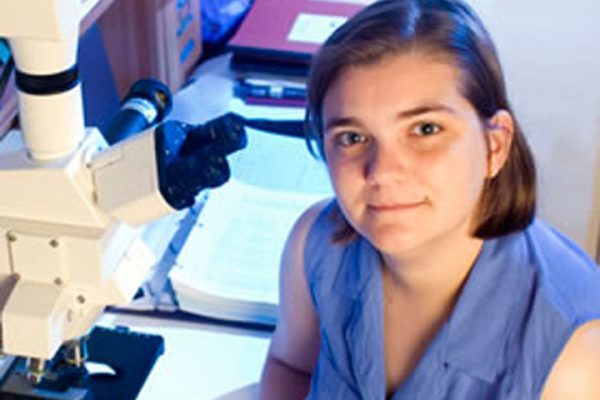
“I wanted to learn as much as I could about harpacticoid copepod taxonomy and one of the leading taxonomists is here,” says Linda Sedlacek, doctoral candidate in Biological Oceanography, as to why she chose to attend Florida State.
Linda has an interest in these small crustaceans (0.2 to 2.5 mm in length) that live in the sediment of seawater, eating detritus and algae. She says, “The number of people capable of identifying and describing new species of these important parts of the food web is diminishing, but my major professor, Dr. David Thistle, is accomplished at it.”
Dr. Thistle is also a favored teacher—”He allows me to take an idea and expand on it. He does not force me to stay within some boundary, but allows me to explore the question completely.”—who has taught Linda how to enjoy teaching. As a new TA for Honors Oceanography, “I was uncomfortable, but he taught me how to explain things. The students and I really enjoyed having an interactive class where they had the opportunity to think through problems.”
Since that time, she has “trained everyone in the Lab, including various assistants and master’s students, how to determine the stage and sex of harpacticoid copepods.” Teaching, she now knows, “can be very gratifying if students are willing to learn. When they begin, they are clumsy with the tools but are excited about seeing so many unique creatures collected from sediment from a nearby beach or from the deep sea.”
On a recent two-week cruise in the Gulf of Mexico, Linda served as Florida State’s lead scientist on cold seep communities (similar to deep-sea hydrothermal vents). She “collected sediment near the cold seeps and methane pools on the seafloor, and helped others with their polychaetes, which live in tubes more than 5 feet long and the crabs, isopods, and clams that live with them.” She traveled to the seafloor in a submersible—”It was amazing watching the fish swim in front of the porthole. And the methane pool was unique. Mussels live all around them, but anything that falls within the pool dies.”
Linda and her major professor have co-written a number of papers on their work for the Marine Ecology Progress Series and for the Journal of Experimental Marine Biology and Ecology. She says, “This work gives me a chance to help others understand the diversity and geographic range of these organisms in the ocean.”




